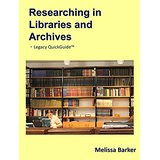Archival materials are something that archivists and conservationists work with on a daily basis. When we are working on an archival project, we reach for the materials we need to help us preserve documents, photographs and artifacts.
As genealogists and home archivists, you need to be using archival materials to preserve the documents, photographs and artifacts you have in your collections. Knowing the right kinds of archival materials to use is a necessity.
For instance, do you know the difference between buffered archival tissue paper and unbuffered archival tissue paper? If not, here is the difference:
Buffered Archival Tissue Paper: This tissue paper is "buffered" because it contains an alkaline substance, usually calcium carbonate, added as an alkaline reserve or "buffer" to counteract acids that may form in the material.
Unbuffered Archival Tissue Paper: This tissue paper is free of the alkaline substance
Most genealogy records, photographs and artifacts would benefit from being archived in buffered materials like boxes, tissue paper, folders, etc. There are some exceptions:
Dye Transfer Prints or Cyanotypes Photographs: Should only be archived in unbuffered materials. These particular types of photographs and/or blueprints should never be archived in buffered materials due to the reaction of the calcium carbonate that could happen with the photographs.
Protein Based Materials: Materials that come from animals should be stored in unbuffered archival materials or at least should not come in contact with buffered materials. These items could include silk, wool, leather, feathers, animal specimens, horsehair, etc.
Using the right materials to preserve our family documents and heirlooms will help them to last for generations to come!
REMEMBER: IT'S NOT ALL ONLINE, CONTACT OR VISIT AN ARCHIVE TODAY!
**********
Need Some Research for Your Next Research Trip!
Get My Legacy QuickGuide
Researching in Libraries and Archives: The Do's and Don'ts
PDF Version: http://legacy.familytreewebinars.com/?aid=1159
Kindle Version: http://amzn.to/2ruqOuT



No comments:
Post a Comment